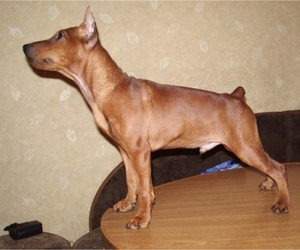All about Meagle dog breed
A.K.A. :Beagle Pin
Meagle is a mix of
Size
Grooming requirements
Exercise requirements
Good with other dogs
Watchdog ability
Energetic
Training requirements
Playful
Affectionate
Good with other pets
Good with children
Good with strangers
Winter
Summer
Healthiness
Protective
Life Span
| Mixed Breeds | Member |
| Breeds A - Z | M |
| Breeds by Group | Hound |
| Breeds by Trait | Good With Kids High Stamina Dog Breeds |
| Overview: | The Meagle, a charming and energetic designer breed, is a delightful cross between the amiable Beagle and the spirited Miniature Pinscher. Originating from the desire to blend the best traits of both parents, this hybrid typically inherits a compact, muscular build, often weighing between 15-30 pounds. Physically, Meagles usually sport a short, sleek coat in various colors, with expressive eyes and either floppy Beagle-like ears or the erect ears of a Min Pin. Temperamentally, they are known for being playful, intelligent, and affectionate, making them wonderful companions for active individuals or families with older children. Their moderate size and adaptability can make them suitable for apartment living, provided they receive ample daily exercise and mental stimulation to prevent boredom. While generally healthy, potential health considerations include those common to their parent breeds, such as hip and elbow dysplasia, patellar luxation, and eye conditions. Early socialization and consistent training are key to fostering a well-adjusted Meagle. |
F.A.Q.
All You Need to Know About the "Meagle" Breed (parent breeds: "Beagle" × "Miniature Pinscher")
The delightful Meagle, a charming cross between a Beagle and a Miniature Pinscher, brings together the best of both worlds. Originating from designer breed programs, the Meagle is known for its energetic and affectionate temperament, making it an excellent family pet. Physically, they are typically small to medium-sized, boasting a short, low-maintenance coat that requires minimal grooming – just a weekly brush. Their appearance can vary, often displaying the Beagle's floppy ears with the Min Pin's sleek build. These intelligent dogs are generally good with children and other pets with proper socialization. While adaptable to apartment living, their lively nature means they need moderate daily exercise to stay happy and healthy, like walks and playtime. Common health considerations for the Meagle include those found in their parent breeds, such as epilepsy, hip dysplasia, and certain eye conditions, so choosing a reputable breeder is crucial for a healthy Meagle puppy. This loyal and playful companion is perfect for active individuals or families seeking a spirited yet manageable canine friend.The average healthy weight for a Meagle (Beagle × Miniature Pinscher mix) is typically between 10 to 20 pounds.Generally, Meagle weight can vary slightly, with males often falling into the higher end of this range and females into the lower end, though significant overlap exists. Factors like parent size (especially the Beagle's weight, which can range more widely) and individual genetics will influence the final Meagle size. A healthy weight for a Meagle ensures proper joint health and overall well-being.
How Tall is a Meagle? Understanding Meagle Height & Size
Considering adding a Meagle to your family and wondering about their adult size? You're in the right place! When it comes to Meagle height, these charming designer dogs are generally on the smaller side, inheriting traits from both their Beagle and Miniature Pinscher parents.The average Meagle height for an adult typically ranges from 10 to 14 inches (25 to 36 cm) when measured at the shoulder. This measurement refers to the distance from the ground to the top of their shoulder blades.It's important to remember that this is an average size, and individual Meagles can certainly fall outside this range. Factors influencing their final adult height include:* Parental Genetics: The specific size of the Beagle and Miniature Pinscher parents plays a significant role. If the Beagle parent was on the smaller side and the Miniature Pinscher parent was average, their offspring might be at the lower end of the Meagle height spectrum.* Gender: While not a drastic difference, male Meagles can sometimes be slightly taller and more robust than female Meagles. However, this is not always the case, and overlap is common.* Individual Variation: Just like people, every dog is an individual! Some Meagles will naturally be a bit taller or shorter due to unique genetic combinations.So, when asking "how tall is a Meagle?", expect a compact and sturdy companion that is perfectly suited for various living situations, from apartments to homes with yards. Their moderate size makes them easy to manage and a delightful addition to most families. Always remember to meet the parents if possible, as this can give you a good indication of your future Meagle's potential adult dimensions!Meagle colors can be quite varied, drawing from both their Beagle and Miniature Pinscher heritage. Common and AKC recognized Meagle colors (for parent breeds) often include black and tan, red, fawn, and chocolate (sometimes referred to as liver). You'll also frequently see tricolor (black, tan, and white), lemon and white, and sable variations. Brindle patterns are also possible, particularly with Min Pin influence. These are generally the most common and accepted Meagle coat types.
For those seeking rare Meagle coat types or exotic Meagle variations, there are indeed less common possibilities. While not officially recognized for the Meagle specifically by major kennel clubs like the AKC (as Meagles are a hybrid breed), these colors can occur due to recessive genes. These include blue (a dilute black), lilac (a dilute chocolate), and even merle in very rare instances, though merle is not typically found in purebred Beagles or Miniature Pinschers and would indicate an unusual genetic background. Such exotic Meagle variations often come with a higher price tag due to their rarity. It's important to note that colors like white are typically seen as markings rather than a solid color, often appearing in conjunction with other standard colors.The Meagle personality is a captivating blend of its Beagle and Miniature Pinscher parents, resulting in an intelligent, playful, and affectionate companion. Known for their energetic temperament, Meagles are generally very friendly and outgoing, often greeting strangers with an enthusiastic wag of their tail. They possess a strong sense of loyalty to their family and thrive on companionship, often seeking to be involved in all household activities.Meagles are highly sociable and typically get along well with other dogs, especially when properly socialized from a young age. Their playful nature also extends to children; they can be wonderful family pets, though supervision is always recommended with very young children due to their spirited energy. While their smaller size might suggest they are ideal for apartment living, Meagles do have moderate exercise needs. Daily walks, playtime, and mental stimulation are crucial to prevent boredom and ensure a well-behaved pet. Without adequate activity, they may exhibit destructive behaviors or excessive barking. Their cleverness and eagerness to please make them relatively trainable, though their Beagle heritage can sometimes present a stubborn streak. Consistent, positive reinforcement training is key to unlocking their full potential.
The Meagle temperament is generally lively, affectionate, and intelligent, making them wonderful companion dogs. They are typically very friendly and sociable, enjoying interaction with their families and often extending that warmth to strangers, though some may exhibit a watchful nature from their Min Pin heritage. Loyalty is a hallmark of the Meagle; they form strong bonds and thrive on being part of the family unit.Regarding adaptability, Meagles can be apartment-friendly due to their moderate size, provided they receive sufficient daily exercise to burn off their energy. Their active minds and bodies require regular walks and playtime.With children, Meagles are usually good-natured and playful, especially if raised with them. Supervision is always recommended with any dog and young children. They generally get along well with other pets, particularly if socialized from a young age, though their Beagle scent drive might occasionally lead them to chase smaller animals.While intelligent, Meagles can exhibit a touch of stubbornness, a trait inherited from both parent breeds. Consistent, positive reinforcement training is key. They can also be somewhat sensitive to harsh corrections, so a gentle yet firm approach is most effective. Expect a dog that is eager to please but may test boundaries. Their charming personality traits make them engaging and loving additions to active households.
Meagle Care: Essential Daily Maintenance for Your Beagle x Miniature Pinscher MixCaring for a Meagle involves understanding the needs inherited from both parent breeds. Here's a concise guide to how to care for a Meagle:Grooming Needs: Meagles typically have short, easy-to-care-for coats. Weekly brushing is usually sufficient to remove loose hair and keep their coat healthy, though they can shed moderately. Occasional baths are needed, especially if they get into something messy. Pay close attention to ear hygiene due to their potential floppy Beagle ears; regular cleaning (weekly or bi-weekly) with a vet-approved solution is crucial to prevent infections. Nail trims every 3-4 weeks are also essential.Exercise Limitations: While alert, Meagles are generally a low-energy dog breed. Daily walks of 30-60 minutes, combined with some playtime, are usually enough to keep them happy and prevent boredom. They enjoy sniffing and exploring, so varied walking routes are beneficial. Avoid over-exercising in extreme weather, especially heat, due to their potential for brachycephalic tendencies (snub nose).Dietary Considerations: A high-quality, age-appropriate dog food is vital for your Meagle's health. Due to their Beagle lineage, Meagles can be prone to weight gain, so strict portion control is crucial for weight management. Consult your veterinarian for specific dietary recommendations and monitor their body condition regularly. Limit treats and avoid table scraps.Wrinkle and Ear Cleaning: Depending on the Beagle influence, some Meagles may have facial wrinkles. If present, these wrinkles need to be cleaned regularly (daily or every few days) with a damp cloth and thoroughly dried to prevent skin irritation and infections. As mentioned, ear cleaning is a must for all Meagles, especially those with floppy ears, to prevent ear infections.Climate Sensitivity (Brachycephalic Anatomy): While not all Meagles are significantly brachycephalic, some may inherit flatter faces from the Min Pin side. This can make them sensitive to heat and humidity. Always provide ample fresh water, shade, and avoid strenuous exercise during hot weather. Watch for signs of overheating, such as excessive panting or lethargy.Common Health Concerns & Health Tips for Meagle:Be mindful of common health tips for Meagle owners. These include regular veterinary check-ups for preventative care. Beagles are prone to skin issues (allergies, hot spots) and certain joint problems, while Min Pins can have patellar luxation. Dental health is critical for both breeds; regular brushing (daily if possible) and dental chews can help prevent periodontal disease. Due to their propensity for weight gain, weight management is a primary concern to prevent related health issues like diabetes and joint problems. Early socialization and training are also important for their well-being.
Meagle Activity Level: How active are Meagles? This charming cross between a Beagle and a Miniature Pinscher typically exhibits a moderate to high energy level. Meagles are known for their playful bursts of energy, often zipping around with enthusiasm, but they also appreciate and require significant downtime for rest. They are a "stop and go" breed, balancing short, intense periods of activity with longer, quieter periods of napping and relaxation.
Daily Exercise Needs: To keep a Meagle happy and well-behaved, plan for at least 30-60 minutes of daily exercise. This can be broken into multiple shorter walks, active playtime in a securely fenced yard, or engaging indoor games. Their Beagle heritage gives them a strong scent drive, making sniff-based games and walks particularly stimulating. Their Miniature Pinscher side contributes to their alertness and desire for interaction.Playtime Preferences: Meagles generally love to play! They enjoy fetch, chase games, and interactive puzzle toys that challenge their minds. Early socialization and consistent training are important to channel their energy positively. They thrive on mental stimulation as much as physical activity.Brachycephalic Considerations: While the Meagle is not typically considered a brachycephalic breed, it's crucial to be aware of their potential anatomical limitations due to the possibility of a shorter snout from the Beagle side. During warm weather or intense exercise, always monitor your Meagle for signs of overheating or breathing difficulties. Avoid strenuous activity during the hottest parts of the day, and ensure they always have access to fresh water and shade. Their moderate size generally makes them less prone to severe brachycephalic issues compared to breeds with extremely flat faces, but caution is always advised.Suitability for Families: Meagles can be suitable for active families who enjoy regular walks and playtime. They also adapt well to low-energy households, provided their daily exercise requirements are met through consistent, shorter bursts of activity. They are not a "couch potato" breed that can go without daily exercise, but they are also not an endurance athlete. They are best suited for owners who can appreciate their playful nature and provide consistent stimulation while also allowing for their need for ample rest.Although Meagles are not extreme brachycephalic dogs, some may inherit a slightly shortened muzzle, making them mildly prone to Brachycephalic Obstructive Airway Syndrome (BOAS). Applying brachycephalic dog care strategies—such as avoiding strenuous activity in hot weather, using a harness instead of a collar, and monitoring breathing during exercise—can help reduce respiratory stress. Their compact, muscular build and active temperament also contribute to heat sensitivity, so they should always have access to shade, water, and cool resting areas. Additionally, their Beagle side may predispose them to spinal problems such as arthritis or intervertebral disc disease, particularly if they jump frequently from heights or carry excess weight.
Understanding how to keep Meagle healthy involves scheduling regular veterinary checkups, early screening for joint, respiratory, and skin conditions, maintaining a balanced diet to prevent obesity, and providing daily exercise to channel their high energy safely. Grooming routines should include brushing to reduce shedding, cleaning ears and skin folds, and dental care to prevent oral disease. With attentive care, Meagles can enjoy a playful, loyal life of 12–15 years.
Breed Breakdown: What Experts Say About the Meagle
I would rate the "Size" trait of the Meagle breed a 3.5. Meagles are a small to medium-sized dog, generally inheriting a compact build from both their Beagle and Miniature Pinscher parents. While Beagles can be a bit sturdier, the Miniature Pinscher influence typically pulls the Meagle's overall size down. You can expect them to be on the smaller end of the companion dog spectrum, not quite toy-sized, but certainly not a medium-large breed either. Their average height would likely fall between 10-15 inches at the shoulder, with weights ranging from 10-25 pounds depending on the dominance of either parent's genes. This makes them an excellent choice for apartment living, especially if they receive adequate exercise. Their manageable size also makes them well-suited for travel, fitting comfortably in carriers or as lap companions. Households with space constraints will find a Meagle quite adaptable, as they don't require vast amounts of room to roam indoors.
The Meagle would likely rate around a 3-4 for grooming requirements. This is a relatively low-maintenance breed. Their short, dense coats, inherited from both parent breeds, mean shedding is moderate, but not excessive, and a weekly brush with a rubber curry or bristle brush is usually sufficient to remove loose hair and keep their coats shiny. They don't typically have significant skin folds that require specialized cleaning. Their ears, while needing regular checks for wax buildup and potential infections, don't usually present extraordinary challenges compared to breeds with long, floppy ears. Nail trims are standard for any dog, and their activity level may help wear them down naturally to some extent, but regular attention is still needed. Bathing is only necessary when they get dirty, not on a frequent schedule, as over-bathing can strip natural oils. While individual dogs can always be susceptible to allergies, neither parent breed is notoriously prone to severe skin issues requiring specialized grooming attention. Overall, the Meagle is an easy-to-care-for breed in terms of grooming, requiring basic routine maintenance rather than frequent, specialized attention.
I would rate the Meagle's exercise requirements as a 7 out of 10. While the Beagle parent contributes a moderate energy level and a love for sniffing and exploring, the Miniature Pinscher brings a much higher intensity and a need for more consistent physical activity and mental stimulation. Meagles are generally energetic dogs that require more than just a casual daily stroll. They thrive on structured routines that include brisk walks or runs, engaging playtime, and opportunities for mental challenges like puzzle toys or scent work. Their agile nature, inherited from the Min Pin, also makes them suitable candidates for activities like agility or obedience training, which can help satisfy their need for both physical and mental engagement. While they don't typically have the extreme demands of working breeds, a lack of adequate exercise can lead to boredom, destructive behaviors, and weight gain. They need consistent activity to stay healthy, happy, and well-behaved, and their tolerance for sustained movement is good, without the respiratory limitations seen in brachycephalic breeds.
I'd rate the Meagle's "Watchdog Ability" a 7 out of 10. This hybrid benefits significantly from the Miniature Pinscher's natural alertness and a strong inclination to announce anything out of the ordinary, which blends well with the Beagle's keen sense of smell and general awareness of its surroundings, even if the Beagle side is more likely to be curious than aggressive. Meagles are typically quite vigilant, quickly picking up on unfamiliar sounds or the presence of strangers approaching the home. They are prone to barking to signal these perceived changes, acting as an effective early warning system. While they might not be overtly aggressive in deterring an intruder, their persistent and often surprisingly loud barks are usually enough to make someone think twice and certainly alert the household. They possess enough territorial instinct to make their presence known, making them more than just a passive companion; they are capable of providing meaningful early warnings in a home environment without necessarily being a full-on guard dog.
I would rate the "Good with Other Dogs" trait of the Meagle a 7 out of 10.Meagles, being a mix of Beagle and Miniature Pinscher, inherit a blend of social tendencies. The Beagle side generally contributes a more pack-oriented and amicable nature, often enjoying the company of other canines. They are typically tolerant and can adapt well to multi-dog households. However, the Miniature Pinscher influence brings a different dynamic. Min Pins can be more independent, sometimes assertive, and possess a strong prey drive, which can manifest as an initial wariness or even a tendency to boss around smaller or more submissive dogs.When properly socialized from a young age, Meagles can be very sociable and enjoy the company of other dogs. They usually adapt well to dogs of various sizes and energy levels, especially if they have grown up with them. They thrive in canine company when provided with consistent positive reinforcement and exposure to different dog temperaments. Without adequate socialization, however, the Miniature Pinscher's more territorial or dominant traits might surface, leading to cautious introductions or potential squabbles with unfamiliar dogs. They generally require careful, supervised introductions to new canine companions, particularly if the other dog is assertive, to ensure a peaceful coexistence. While aggression is not a primary concern, a lack of early socialization could lead to a dog that is less tolerant or more prone to expressing dominance, rather than a truly dog-friendly temperament. With the right foundation, they can be excellent companions in a multi-dog household, but they aren't always a "go with the flow" dog when it comes to every new canine encounter.
I would rate the Meagle's "Energetic" trait a 7 out of 10.The Meagle inherits a significant amount of energy from both its parent breeds. The Beagle is renowned for its boundless stamina, developed for long hunts, and the Miniature Pinscher is a lively, confident dog with a strong prey drive and a need for activity. This combination results in a dog that is naturally active and playful, far from laid-back. Meagles typically have a good endurance for walks, games of fetch, and other outdoor activities, and their playfulness often manifests in bursts of zoomies and an eagerness to engage with their owners. They thrive on physical stimulation and will become bored and potentially destructive if their energy isn't adequately channeled.While the Meagle generally has good exercise tolerance, it's important to consider that a small percentage of Meagles might inherit some degree of brachycephaly, or a shortened muzzle, from their Miniature Pinscher parent (though the Min Pin is not as severely brachycephalic as some breeds). If a Meagle does have a noticeably shorter snout, this could potentially affect its stamina and exercise tolerance, especially in hot or humid weather, as it may have more difficulty breathing. In such cases, vigorous exercise should be monitored carefully to prevent overheating or respiratory distress. However, for most Meagles, this is not a significant limiting factor, and they generally possess the vigor and enthusiasm to participate in a wide range of outdoor and athletic activities.
I would rate the Meagle's training requirements a 7 out of 10.While intelligent and capable of learning, the Meagle inherits a significant amount of stubbornness from both the Beagle and Miniature Pinscher. Beagles are known for their independent nature and following their nose, often tuning out human commands. Miniature Pinschers, while intelligent, are also very headstrong and have a "what's in it for me?" attitude. This combination means that while they can be responsive to commands, consistency is absolutely paramount, and they will test boundaries constantly. Their attention span can be moderate, but easily diverted by interesting smells or sights, especially when outdoors. Positive reinforcement, particularly with high-value treats and praise, is highly effective, but trainers must be creative and persistent to keep their interest. This breed is not beginner-friendly and requires experienced handling and structured routines from day one to establish clear expectations and prevent undesirable behaviors from taking root. Without firm, consistent, and patient training, a Meagle can easily become an unruly and challenging companion.
I'd rate the Meagle's "Playful" trait an 8 out of 10.Meagles are generally quite spirited and engaging, blending the Beagle's boundless curiosity and love for activity with the Miniature Pinscher's feisty and alert nature. They typically exhibit a high activity level, especially as puppies and young adults, and possess a strong love for games and interaction. You can expect them to be highly responsive to toys, often enjoying fetch, tug-of-war, and puzzle toys that challenge their intelligent minds. Their attention-seeking behavior is usually expressed through playful nudges, bringing toys, or inviting their owners to join in their fun. While not as hyperactive as some terrier breeds, they are certainly not laid-back; they thrive on mental and physical stimulation and will eagerly participate in daily activities, making them enthusiastic and fun-loving companions.
I would rate the Meagle's "Affectionate" trait at an 8.Meagles generally inherit a strong desire for human companionship from both parent breeds. The Beagle's pack mentality translates into a need to be part of the "human pack," while the Miniature Pinscher, despite its independent streak, is known for its devotion to its family. Meagles often exhibit a keen sensitivity to their owner's emotions, often offering comfort or mirroring the mood of the household. They thrive on physical closeness, enjoying cuddles, lap-sitting, and will happily follow their family members from room to room, seeking to be involved in whatever is happening. While they might not be as overtly clingy as some "velcro" breeds, they certainly benefit from and actively seek out affection, becoming deeply loyal companions. Their independent side, primarily from the Min Pin, means they aren't usually prone to separation anxiety if properly trained and socialized, but they definitely prefer to be with their people rather than left alone for extended periods.
I'd rate the "Good with Other Pets" trait of the Meagle as a 7/10.The Meagle inherits a blend of traits from its parent breeds. The Beagle generally possesses a friendly and sociable nature, often getting along well with other dogs and even cats, especially when raised together. However, they do have a strong scent-driven prey drive that can be problematic for smaller, fast-moving pets like hamsters or birds. The Miniature Pinscher, on the other hand, can be more territorial and assertive. While intelligent and capable of forming strong bonds, they may have a higher prey drive than Beagles and can exhibit resource guarding tendencies if not properly socialized and trained.Therefore, a Meagle's success in a multi-pet household largely depends on the individual dog's temperament, which can lean more towards one parent than the other, and most importantly, on early and consistent socialization and training. They are not naturally *uniformly* sociable to the extent that they require no intervention. With proper introductions, consistent supervision, and training to manage prey drive and any potential resource guarding, Meagles can absolutely coexist peacefully and even form friendships with other pets. However, without this dedicated effort, especially regarding the Miniature Pinscher's more independent and potentially bossy traits, friction can arise, particularly with cats or smaller animals. Their potential prey drive means smaller, non-canine pets would require careful consideration and likely dedicated separation when unsupervised.
Rating: 6/10The Meagle, a mix of Beagle and Miniature Pinscher, can be a moderately good companion for families with children, though some caveats apply, leading to a respectable but not top-tier rating. Their temperament is a blend of their parent breeds, which can be a double-edged sword. From the Beagle, they inherit a generally friendly, outgoing, and playful nature. This contributes to their willingness to engage in games and their ability to be quite affectionate with children. Beagles are also relatively patient, which helps with the often unpredictable nature of kids.However, the Miniature Pinscher influence introduces a more assertive and sometimes less tolerant side. Min Pins can be prone to being a bit nippy or defensive if they feel threatened or handled roughly, especially by younger, less-aware children. While intelligent, the Meagle may inherit a degree of stubbornness from both parents, meaning consistent training and early socialization are crucial to ensure they understand boundaries and are comfortable with the boisterousness of a household with kids. Their tolerance for noise can vary; while the Beagle's hunting background might make them somewhat resilient to common household sounds, the Min Pin's more alert and sometimes nervous disposition could lead to some reactivity to sudden loud noises or overly enthusiastic children.They are generally playful, especially with older children who understand how to interact respectfully, and their moderate energy levels make them good companions for walks and playtime. However, younger children might need significant supervision to ensure they don't inadvertently provoke a less patient reaction from the Min Pin side of the Meagle. They aren't naturally gentle to the extent of some famously child-friendly breeds, often requiring that training and early exposure to children shape them into a more tolerant and predictable family member. With proper guidance, socialization from a young age, and an understanding of both the dog's and the children's boundaries, a Meagle can thrive in a family setting, but they aren't a "set it and forget it" breed when it comes to child compatibility.
I would rate the "Good with Strangers" trait of the Meagle as a 6 out of 10. While the Beagle parent contributes a naturally friendly and generally outgoing disposition, the Miniature Pinscher side often brings a more reserved, watchful, and sometimes even wary nature towards unfamiliar individuals. Meagles are typically not aggressive towards strangers, but they are unlikely to be immediately effusive. They often display initial curiosity mixed with a degree of caution, and may bark to alert their owners to new arrivals. With proper socialization from a young age, most Meagles can learn to be comfortably polite and accepting of strangers, but they are not inherently as universally welcoming as some other breeds. They tend to be more adaptable in public environments if well-socialized, but may still prefer to observe rather than actively engage with every passerby.
I'd rate the Meagle's "winter" tolerance at a 4.While the Beagle parent contributes a denser coat and a more robust build, the Miniature Pinscher side significantly diminishes the Meagle's cold-weather resilience. Miniature Pinschers have very short, fine coats with little to no undercoat, minimal body fat, and a small, lean physique, making them highly susceptible to cold. Meagles generally inherit this shorter, less insulating coat, even if slightly denser than a pure Min Pin's. Their small to medium size, depending on the individual, also means they lose heat more quickly than larger breeds. They are not brachycephalic, so breathing in cold air isn't typically an issue in that regard, but their overall body composition still puts them at risk of hypothermia. They can enjoy short bursts of outdoor activity in chilly weather, but prolonged exposure, especially in freezing temperatures, is not advisable.Compared to many other companion dogs, Meagles absolutely require special care during winter months. They will likely need a warm sweater or jacket for outdoor excursions when temperatures drop, and their time outside should be limited. Owners in colder climates should be vigilant about monitoring for signs of discomfort or shivering, and ensure they have a warm, draft-free indoor environment. They are not a breed that can be left outside for extended periods in winter.
I would rate the "Summer" tolerance of the "Meagle" breed as a 6.The Meagle inherits a blend of characteristics from its parent breeds. Beagles are generally quite active and possess a moderate single coat, which offers some insulation but can still lead to overheating with strenuous activity in the sun. Miniature Pinschers, on the other hand, have very short, sleek coats and are typically more sensitive to cold, but their smaller size can make them prone to overheating if not managed. Neither parent breed is brachycephalic, meaning the Meagle is unlikely to have the severe respiratory compromises that significantly increase heatstroke risk in breeds like Bulldogs or Pugs. This allows for more efficient breathing and thus better heat regulation compared to true brachycephalic breeds. However, the Meagle's potential for high energy levels, especially if it leans towards the Beagle's drive, means they can easily overexert themselves in warm weather. While they can generally tolerate moderate summer temperatures for brief periods, extended outdoor activity, particularly during the hottest parts of the day or without access to shade and water, poses a significant risk of heatstroke. They are not as vulnerable as brachycephalic breeds, but they are also not as robust as large, short-coated, naturally heat-tolerant breeds like Greyhounds or Rhodesian Ridgebacks. They will require special care in summer months compared to many other companion dogs, particularly those with double coats or a more laid-back disposition, in that their activity levels need to be carefully monitored and adjusted, and they should have access to air conditioning or cool environments during peak heat.
I would rate the Meagle's "Healthiness" trait as a 7 out of 10.The Meagle benefits from hybrid vigor, often inheriting a broader genetic pool than its purebred parents, which can reduce the incidence of some breed-specific issues. Both Beagles and Miniature Pinschers are generally robust breeds with decent lifespans, contributing to the Meagle's overall hardiness. However, Meagles can still be susceptible to conditions seen in their parent breeds. From the Beagle side, this might include disc disease, epilepsy, and hypothyroidism. From the Miniature Pinscher, there's a potential for patellar luxation, Legg-Calve-Perthes disease, and certain eye conditions like progressive retinal atrophy. They are not typically prone to extreme breathing difficulties or severe skin conditions common in some other breeds.With responsible breeding practices (screening parents for known genetic issues) and consistent preventive care (proper diet, exercise, and regular veterinary check-ups), a Meagle can lead a long and healthy life, often exceeding 12-14 years. They are not considered high-maintenance in terms of health, but like any dog, they do require attention to their diet to prevent obesity, and exercise to maintain joint health and muscle tone. Overall, they are generally robust compared to many other companion dogs, but not without their potential inherited weaknesses.
Rating: 7/10The Meagle, a cross between the Beagle and the Miniature Pinscher, generally exhibits a notable degree of protectiveness, leaning more towards a vigilant watchdog than a truly formidable guard dog. The Miniature Pinscher lineage contributes significantly to its alertness and territorial instincts; Min Pins are known for their "king of toys" attitude and will readily bark at anything they perceive as an intruder or a threat to their home and family. This translates to the Meagle being quick to notice and vocalize about strangers approaching the property or unusual sounds.Their loyalty to owners is typically strong, forming close bonds and having a natural inclination to be aware of their owner's safety within their perceived territory. When it comes to reactions to strangers, a Meagle is likely to be wary and vocal. They'll probably bark persistently, creating a deterrent through noise and presence, rather than through physical aggression. While they might stand their ground, their smaller size, inherited from both parents, limits their capacity for physical protection. They are more of a "living doorbell" or an excellent alarm system, suitable for alerting household members to potential issues. They excel as companion dogs that are also very good at providing an early warning system, making them capable of offering meaningful, albeit non-physical, protection in a household setting by making their presence and disapproval known.
I would rate the "Life Span" trait of the Meagle breed a 7 out of 10. This places them in the "long-lived" category compared to many other companion dogs. Meagles typically enjoy a good average life expectancy, generally ranging from 12 to 15 years, which is quite respectable for a medium-small sized dog. This favorable longevity is primarily due to the genetic contributions of both parent breeds. Beagles are known for their sturdy health and often live well into their teens, and while Miniature Pinschers can have some specific health concerns, they also generally have a good lifespan. The hybrid vigor often associated with designer breeds like the Meagle can contribute to a reduction in the prevalence of some breed-specific genetic diseases that might be more common in purebred Beagles or Miniature Pinschers. However, they can still inherit predispositions to conditions like patellar luxation, dental issues, and some eye conditions from their parent breeds, which, if not managed, could theoretically impact their lifespan. Responsible breeding practices, including health screenings of parent dogs, and good owner care, such as a balanced diet, regular exercise, and preventative veterinary check-ups, are crucial in helping Meagles reach the upper end of their life expectancy.
Meagle Dogs for adoptionSee all dogs for adoption
Similar Dog Breeds for Meagle
Quick Breed Selector 0 - not important, 1 - smallest, 10 - largest
Variants & Mistakes :Meagel, Megle, Meaglel, Miggle, Maegle, Meegle, Miegel, Meaglle, Meagl, Megel, Megale, Meigle, Maigle






